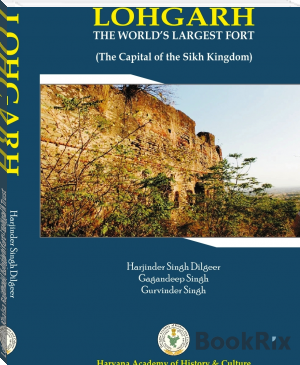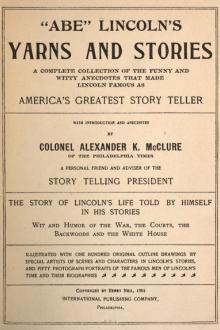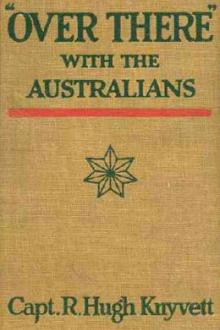Lohgarh - Khalsa Rajdhani, Lohgarh fort - Lohgarh Trust, S. Daljeet Singh Bajwa [early reader books .txt] 📗

- Author: S. Daljeet Singh Bajwa
Book online «Lohgarh - Khalsa Rajdhani, Lohgarh fort - Lohgarh Trust, S. Daljeet Singh Bajwa [early reader books .txt] 📗». Author S. Daljeet Singh Bajwa
Not only Banda Singh, but even the biggest Fort of Lohgarh has met injustice at the hands of historians. Historians have narrated that this was a small Fort, which existed before Banda Singh ‘occupied’ it. The fact is it belonged to the Sikhs. Banda Singh did not capture it; in fact, he chose to have this Sikh Fort as his capital.
Again, some historians have also tried to misrepresent the events of November-December 1710 by saying that the Mughal army captured Lohgarh in just one day. This book proves that no one could have captured this Fort even in 5-6 years. Interestingly Muhammed Qasim Aurangabadi had accepted that this Fort was almost invincible.
Lohgarh Fort, which should have been a matter of pride for history, remained concealed due to the injustice done to it. Perhaps some historians did not want to present its glory because by doing so, they would have had to show the mighty Mughal army in poor light.
Lohgarh came into limelight when the Haryana government held a state-level function to celebrate the 300th martyrdom of Banda Singh Bahadur last year. Gagandeep Singh DDPO Yamuna Nagar, explored relevant literature pertaining to Lohgarh Fort which gave an indication that it existed at the boundary of Haryana and Himachal Pradesh on a small hill, where the Mughal army attacked in early 18th century to
suppress the Sikh rebellion. War continued here for more than three years. A general feeling arose in our mind, as to how a Sikh army from a small Fort could withstand the powerful Mughal forces. To unveil the facts, intensive survey of the forest area at this location were conducted with a view that the Fort area may be far larger than was given in the available literature. On the request of the Deputy Commissioner, Yamuna Nagar, higher administration of Himachal Pradesh extended its support and appointed forest Officer (T) for assistance to explore forest area around the Lohgarh Fort. Initially it was expected that Fort may be spread over 500 to 600 acres of land, but to our great surprise, remnants of the Fort were found in more than 7000 acres of forest land on a number of hills. This fact was brought to the notice of the local Sikh Sangat and a trust was formed under the chairmanship of S. Gurvinder Singh Karnal, who is also the co-author of this book. A dynamic Sikh activist named S. Jarnail Singh extensively worked with S. Gagandeep Singh in all activities of explorations of the Fort area and collected number of evidences of the Fort. MOUs were signed with professional agency, which endorsed the facts that the remnants of the Fort are spread in a vast area. The trust has also associated a Delhi-based heritage revival company, the Indian Trust for Rural Heritage and Development (ITRHD).
The ITRHD research about Lohgarh has revealed that the Lohgarh Fort included Fort walls, bastions, rooms, soldier barracks, watch towers, grindstone, hand mills to mill and big clay drums for the storage of food grains. Many carved stones were also found. “The Fort walls are made of dressed stones and lime. Mortar mixed with brick powder has been used as the binding materials. The bricks used in the Fort walls are of five different sizes,” says SK Mishra, IAS (Retd.) and ITRHD Chairman. Archeological studies have thrown up astonishing facts. Lohgarh was declared Khalsa Rajdhani by Baba Banda Singh Bahadur in 1710 and the epicenter of its Fort was spread across 7,000 acres, making it one of the largest Fort in the world.
When we (myself Gurwinder Singh and Gagandeep Singh) expressed our wish for unveiling the truth in the context of Lohgarh, Dr Harjinder Singh Dilgeer immediately came forword to support us and gave all his
Foreword & Acknowledgement u 17
materials to us and asked us to take up this project. We are very happy that we could fulfil our duty to bring the truth to light.
Jarnail Singh, a retired army official, spent several months exploring the Lohgarh Fort zone by actually visiting hundreds of hills. All materials about the structure and geographical location of Lohgarh Fort was done by Gagandeep Singh. Similarly, most of the materials about the battles of Lohgarh, the Vanjaras and the Sikligars, background of Sadhura, life of Pir Budhu Shah too was written by Gagandeep Singh. All the pictures, which have been published in this book, were taken by Gagandeep Singh, Gurvinder Singh and Jarnail Singh.We are thankful to Baba Sukha Singh, Diljeet Singh, Prithi Pal Singh, Harjinder Singh, Parmjeet Singh, Manmohan Singh, Gurvinder Singh, Gurbhax Singh, Gurpreet Singh, Harjeet Singh, Narinder Singh, Shiv Shankar Pahwa, Hardev Singh, Charan Singh Arvinder Pal Singh, JS Mirpur, Rishi Pal Singh, Sukvinder Singh, Gobind Singh, Joginder Singh, Satinder Singh all associated with Lohgarh Trust, Yamuna Nagar, who made noteworthy contribution in unveiling facts pertaining to the Lohgarh-Khalsa Rajdhani. A special thanks to Adarshdeep Singh, Deputy Superintendent of Police, Govt. of Haryana, for providing the necessary support during the survey of the Fort Lohgarh. We are also thankful to the concerned Sarpanches, Gram Sachivs, Patwaris and the staff of DDPO office, Yamuna Nagar, who helped in compiling the important information in the context of Lohgarh. We also wish to record our thanks to the Haryana Academy of History & Culture, Kurukshetra for publishing this study.
Our sincere thanks to Shri Manohar Lal Ji, the Honourable Chief Minister of Haryana, for writing some kind words for our research work.
Harjinder Singh Dilgeer Gurvinder Singh, (Chairman, Lohgarh Trust)
Introduction
Lohgarh –Khalsa Rajdhani (in the present Yamuana Nagar district of Haryana) is one of the most important places in Sikh history. From here the flag of Sikh sovereignty was raised in 1710, by the great Sikh General- Baba Banda Singh Bahadur. The cliometrics techniques used for new historical reflection discoveries, evidences, facts, and its interpretations, produces altogether a new history of Sikhism and Lohgarh Fort – the Khalsa Rajdhani. It will serve as a potential new reference, not only for Sikh history, but also the world history. After perusal of the Sikh history, we come across three Lohgarh-Forts, which were built by Sikh Gurus at different points of time. Under the leadership of the Sikh Gurus, it took almost 70-80 years for establishing such a huge Fortification at Lohgarh. The epicenter of Lohgarh Fort spread in more than 7000 acres; and dozens of small Fortresses and Chowkis (army posts) were established in the Shivalik hills in the present districts of Yamuna Nagar, Ambala and Panchkula. Fortresses were set up right from Indri, Ladwa, Babain, Shahbad, Barara, Ambala, Shahjadpur, Jagadhri, Sadhaura, Mustafabad, Raipur Rani and Pinjore to deal with the aggression of the mammoth army of the Mughals. Altogether this was made out to uproot the Mughal Empire from the Indian Sub-Continent, who made emergence atrocities to natives.
For making of such a huge Fortification a lot of fund was required and therefore a common wealth was created by the Vanjara and the Labana communities to raise funds for the construction of the Lohgarh Fort. The tandas (halting places of the trade caravans of the Vanjaras, which have now become villages) made special endeavours throughout
the Indian Sub-Continent to raise finances for the cause of freedom from foreign yoke. In the early eighteenth century the Mughal economy was 24.4% of the world’s economic system and the Vanjaras Sikhs were the primary players of it. The Vanjaras were so rich traders that the Mughals had assigned them ‘mansabs’ in various regions of the Empire. The Vanjaras were the richest population of the nation and even had political power, but their feeling of nationalism was unmatched, they worked wisely and secretly, for many decades, to fulfill the mission of the Lohgarh Fort. Bhai Lakhi Rai Vanjara was the main leader behind the objective and a large number of nayaks (leaders) and the Vanjaras followed his path.
Banda came to Punjab with a large number of men around him and tandas of Vanjara Sikhs circulated the Hukamnama of Guru Sahib – stating war against the Mughals has opened and Sikhs were ordered to join Baba Banda Singh Bahadur. This rebellion was not against a small monarch, but it was against the world’s most powerful empire. The battles of Lohgarh were fought mainly by the Vanjaras, the Labanas and the Sikhligars. After the battles of Lohgarh (1710-1716), the Mughal Empire began gradually declining. Later on after the capturing of Baba Banda Singh Bahadur, the Vanjaras tried to carry on the battle against the Mughals, but could not sustain for want of a great leader. The Mughal regime inhabited 85 villages with Rangar people (the Rajputs turned Muslims) in the vicinity of Lohgarh; and, with this the Vanjaras had to yield a very big toll. This was the beginning of their genocide in the Northern India and the royal farmans (command) were issued that wherever Nanakprast (Sikhs) found, they should be killed right there and the person killing them shall be rewarded with 10 rupees per head; this was a big amount in those days. This continued for the next 30 to 40 years, i.e. up to 1750s, till the Sikh Misls captured this region and set up their administrative control over this region. The Sikh feudals never bothered to take charge of their Vanjara Sikh brethren who were passing their life in misery in the hills bordering the former district of Ambala.
After the battles of Lohgarh no population was left in the district.It is worthwhile to mention here that most of the population inhabiting
Introduction u 21
the present districts of Yamuna Nagar, Ambala and Panchkula, is not more than 250 years old. In 1852, the Bristish Government appointed the first consolidation officer Kale Rai (Rangar) for reinhabitation of population in the said area.
Some historians have wrongly stated that the Lohgarh Fort was a new name given to the already existing Muklishgarh Fort (which was, in fact, not a Fortress, but was ‘Rang Mahal’ i.e. palace of joy of the Mughal Emperors and generals). The mighty Lohgarh Fort was falsely and fictitiously projected as Mukhlispur simply to dilute the glorified history of the Lohgarh Fort, which was constructed by the natives to uproot the alien and oppressive rule of the Mughals. Muklishgarh is situated near Hathni Kund Barrage and is approximately 35 km away from Lohgarh Fort. The contemporary Mughal historians like Khafi Khan, Mohammed Qasim Aurangabadi and others deliberately projected a wrong picture of Lohgarh as Muklishgarh. Later on, Alexander Cunningham, who was a British army engineer with the Bengal Engineer Group, held an interest in the history and archaeology of India. In 1861, he was appointed to the newly created position of the Archaeological Surveyor to the Government of India, and, he founded and recorded (what later became Archaeological Survey of India). He also surveyed this area, but he, too, deliberately, never submitted any report on Lohgarh. He even wrote a note on the Sikh history, but never made any true reference to Lohgarh Fort. All the later historians picked references in its context from the above cited authors, thus got a faulty interpretation of the history of Banda Singh Bahadur, the battles of Lohgarh, the Vanjaras and the Sikligars.
The British Gazetteer of the territorial dominion of old Ambala, published in 1893, makes no reference of the Fort of Lohgarh, though the British Gazetteer of district Saharanpur, makes a reference to Muklishgarh (the pleasure palace of the Mughals). After the Britishers occupied this area in the middle of the 19th century, the





Comments (0)